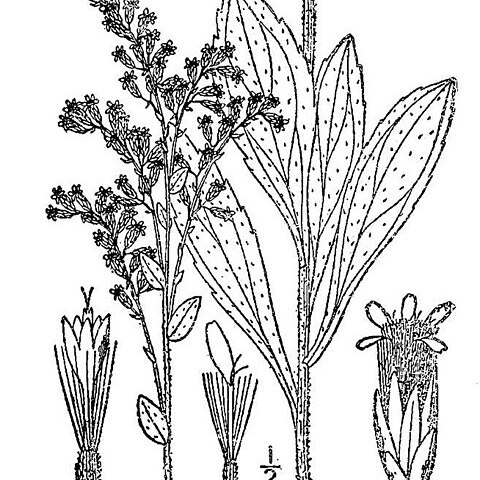Plants 30–90 cm; caudices, sometimes also creeping rhizomes as well. Stems usually 1–3, ascending to erect, scabrous to loosely puberulent. Leaves: basal and proximal usually withering by flowering, tapering to long-winged petioles, blades oblanceolate, 30–100 × 7–20(–30) mm, margins serrate or crenate, mid usually largest, apices acute to obtuse, acuminate, faces scabrous; mid and distal cauline subsessile (1 mm) or sessile, blades (sometimes ± shiny) elliptic to oblanceolate, 10–50 × 5–15(–25) mm, greatly reduced distally, grading into bracts, firm, bases convex-cuneate to rounded, margins finely serrate , often 3-nerved, nerves usually distinct abaxially, faces distinctly scabrous. Heads 20–260, in paniculiform arrays, narrowly to broadly secund, pyramidal, branches recurved, secund. Peduncles 0.5–2 mm; bracteoles 1–5, linear-lanceolate to ovate, minute, grading into phyllaries distally. Involucres narrowly campanulate, 3–5 mm. Phyllaries in 3–4 series, unequal, oblong, midnerves swollen distally, obtuse or acute to slightly acuminate. Ray florets 4–7; laminae 2–3.5 × 0.2–0.7 mm. Disc florets 4–6; corollas 3 mm, lobes 1 mm. Cypselae 1.5–2.5 mm, sparsely to moderately short-strigose; pappi 3 mm. 2n = 18, 36.
More
Plants 4–12 dm from a caudex, at least sometimes with creeping rhizomes as well; stem scabrous to shortly and loosely hirsute; lvs chiefly cauline, numerous, firm, elliptic or lance-elliptic to rather narrowly elliptic-obovate, subsessile, obscurely to evidently toothed or the upper entire, ± evidently trinerved, subglabrous, or more commonly scabrous-hirsute (seldom more softly spreading-hairy), mostly 2–5 times as long as wide, the larger ones 3–8 × 1–3 cm; infl paniculiform, with densely fld, ± recurved-secund branches, or occasionally simple and nodding; invol glabrous, 3.5–5.5 mm, its bracts relatively broad and firm, acutish to more often obtuse or broadly rounded; rays 4–7,2–3.5 mm; disk-fls 4–6; achenes short-hairy; 2n=18. Open, rocky places and dry woods, especially in calcareous soil; Mo. and s. Ill. and w. Ky. to Okla., La., and Tex.; N.C.; Ga.

